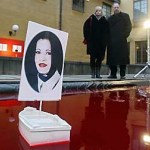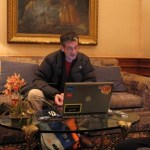Museums
I've blogged before about becoming an archaeological dad, when new work built upon and superseded stuff I did in the 90s. Now stuff I did in the 00s has become, if not history, then at least museology, in the pages of Dr. Carl-Johan Svensson's PhD thesis in didactics (freely available on-line as a 2.4 MB PDF file). He presented his thesis yesterday at the School of Education and Communication, Jönköping University.
Ten years ago I was involved a drawn-out and pretty violent public dispute about the policies of the then director of the Museum of Swedish History – which is misnamed because its…
Contract archaeology is the current term for what used to be called rescue archaeology: documenting archaeological sites slated for destruction through land development. (Swedes sometimes fall for a false friend and translate an old word of ours, exploateringsarkeologi, into “exploitation archaeology”, suggesting fieldwork undertaken by people in pimp/ho outfits to the soundtrack from Shaft.)
Swedish contract archaeology has seen steady growth measured decade by decade since the end of WW2, both in terms of the number of active field archaeologists and of the number of units. I seem to…
A great two-part series on great computing museums from the last few issues of Communications of the ACM (here and here).
The museums they profile are:
The Computer History Museum
The Heinz Nixdorf MuseumsForum
The Science Museum in London
The Deutches Museum
U.S. National Museum of American History
I'll include an extra bit from the first CACM article on the Computer History Museum in Mountain View, CA. I'm choosing that one because as it happens I'll almost certainly be visiting it this coming July. I'm fortunate to have been invited to the annual Science Foo Camp, which happens to be at…
tags: Koralle, Senckenberg Naturmuseum, museums, Frankfurt am Main, Germany, travel, nature, cities, image of the day, photography
Koralle.
Senckenberg Naturmuseum, Frankfurt am Main, Germany.
Image: GrrlScientist, 13 April 2010 [larger view]
Brain coral is a common name given to corals in the family Faviidae, so called due to their generally spheroid shape and grooved surface which resembles an animal brain. Each head of coral is formed by a colony of genetically identical polyps which secrete a hard skeleton of calcium carbonate; this makes them important coral reef builders like other…
tags: Koprolithen, Senckenberg Naturmuseum, museums, Frankfurt am Main, Germany, travel, fossils, paleontology, image of the day, photography
Koprolithen.
Senckenberg Naturmuseum, Frankfurt am Main, Germany.
Image: GrrlScientist, 13 April 2010 [larger view]
tags: Fledermaus Hologramm, Senckenberg Naturmuseum, museums, Frankfurt am Main, Germany, travel, fossils, paleontology, image of the day, photography
Fledermaus Hologramm.
Senckenberg Naturmuseum, Frankfurt am Main, Germany.
Image: GrrlScientist, 13 April 2010 [larger view]
tags: Koralle, Senckenberg Naturmuseum, museums, Frankfurt am Main, Germany, travel, fossils, paleontology, image of the day, photography
Koralle.
Senckenberg Naturmuseum, Frankfurt am Main, Germany.
Image: GrrlScientist, 13 April 2010 [larger view]
This is another beautiful coral that I photographed recently at the Senckenberg Naturmuseum. If you were here today, I would unfortunately opt to show you photographs instead of venturing out into the volcanic ash. However, if you were here, you and I would recall the Mt St Helens explosion over cold beers, and we would look at the jar of…
tags: Trilobiten Abdruck, Senckenberg Naturmuseum, museums, Frankfurt am Main, Germany, travel, fossils, paleontology, image of the day, photography
Trilobiten Abdruck.
Senckenberg Naturmuseum, Frankfurt am Main, Germany.
Image: GrrlScientist, 13 April 2010 [larger view]
Impressions
by Ryan Jennings
A lifetime can be likened to a lonely beach of sand.
a stranger makes a mark one day, an imprint of a hand.
As time goes by the beach once clear is now a cluttered field
of memories and keep-sakes of the ones that we hold dear.
Time does its best to wash away remembrances of those -
the ones…
tags: Lituites lituus, Senckenberg Naturmuseum, museums, Frankfurt am Main, Germany, travel, fossils, paleontology, image of the day, photography
Lituites lituus.
Senckenberg Naturmuseum, Frankfurt am Main, Germany.
Image: GrrlScientist, 13 April 2010 [larger view]
If you were here today, I would show you this lovely Ordovician fossil shell. The Ordovician Period began with a series of major extinction events that ended the Cambrian Period roughly 488.3 ± 1.7 million years ago, and lasted for about 44.6 million years. Despite a world filled with destruction, death and mass extinctions,…
tags: Fels, Senckenberg Naturmuseum, museums, Frankfurt am Main, Germany, travel, nature, cities, image of the day, photography
Fels.
Senckenberg Naturmuseum, Frankfurt am Main, Germany.
Image: GrrlScientist, 13 April 2010 [larger view]
This is a close look at a large rock standing on the grassy traffic island in front of the Senckenberg Naturmuseum. The grain shows how tortured this rock was when it was still soft.
tags: Versteinerung Muschelschale, Senckenberg Naturmuseum, museums, Frankfurt am Main, Germany, travel, nature, cities, image of the day, photography
Versteinerung Muschelschale.
Senckenberg Naturmuseum, Frankfurt am Main, Germany.
Image: GrrlScientist, 13 April 2010 [larger view]
This is a gorgeous fossil shell photographed at the Senckenberg Naturmuseum .. how old is this? What species is this? I don't know .. but I will return and collect more detailed information to share with you (this first visit was a quick pass through the museum to see what they have on display).
tags: Koralle, Senckenberg Naturmuseum, museums, Frankfurt am Main, Germany, travel, nature, cities, image of the day
Koralle.
Senckenberg Naturmuseum, Frankfurt am Main, Germany.
Image: GrrlScientist, 13 April 2010 [larger view]
If you were here today, I would show you around the Senckenberg Natural History Museum. During your visit, this is one of the many natural wonders you would see.
tags: evolutionary biology, AMNH, American Museum of Natural History, New York City, mammals, biodiversity
Because I write for ScienceBlogs, I have been invited to a special sneak preview of the "Extreme Mammals" exhibit hosted by the American Museum of Natural History, where I was a postdoctoral fellow for two years. This exhibit features the biggest, smallest, most amazing and generally the weirdest mammals to ever swim, fly or walk the face of this earth. "Extreme Mammals" opens to the public on Saturday, 16 May, but my goal is to take a lot of photographs to share with you here this…
tags: evolutionary biology, AMNH, American Museum of Natural History, New York City, mammals, biodiversity
Because I write for ScienceBlogs, I have been invited to a special sneak preview of the "Extreme Mammals" exhibit hosted by the American Museum of Natural History, where I was a postdoctoral fellow for two years. This exhibit features the biggest, smallest, most amazing and generally the weirdest mammals to ever swim, fly or walk the face of this earth. "Extreme Mammals" opens to the public on Saturday, 16 May, but my goal is to take a lot of photographs to share with you here on the…
After coffee cupping, still pretty frozen, we went back to Radisson to see who else has arrived for ScienceOnline09 in the meantime. I set up my temporary field Headquarters in the lobby (photo by Lenore):
After a quick lunch, it was time for Lab Tours (check blog posts and pictures for other people's experiences). A bunch of us went to the NC Museum of Natural Sciences where Roy Campbell, the Director of Exhibits, gave us a fantastic whirlwind tour through the Museum and the vaults, the secret basement chambers that general public cannot access.
I've been going to the Museum for 17…
New Orleans, January 2009
The first major public exhibit to open in New Orleans after Hurricane Katrina was the Audubon Nature Institute's Insectarium. We took advantage of a lull in our schedule last week to make the pilgrimage to what turns out to be a surprisingly ambitious operation. It well exceeded our expectations.
The entrance on Canal Street.
Spying on live bumblebees.
Inside the bees' nest.
Yes, educational bits too.
This ant looks familiar.
Not a family exhibit: stick insects have sexual relations in public.
They let non-insects in too.
Another one…
I am minutes away from shutting down this computer to pack it away for the long trip to Illinois tomorrow, but before I do that let me point out the New York Times' review of what may well be the most ambitious arthropod exhibit ever: The New Orleans Insectarium.
If any of you have the opportunity to visit the Insectarium, drop me a line as to what you think. I've not had the chance to see it, but I do have several photographs appearing in the displays and am curious about how they look.

